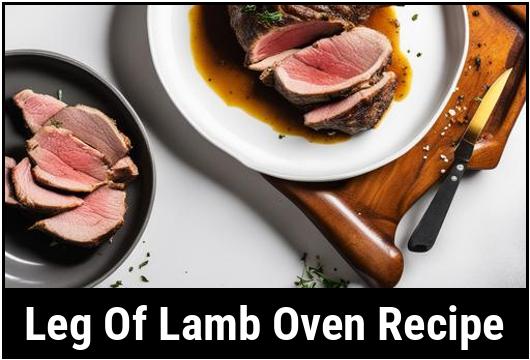
The Perfect Leg Of Lamb Oven Recipe: A Culinary Masterpiece
Cooking a leg of lamb in the oven can be an incredibly satisfying and delicious endeavor. This versatile and succulent cut of meat is often reserved for special occasions, but with the right technique, anyone can create a mouthwatering masterpiece. In this comprehensive guide, we will delve into the world of leg of lamb oven recipes, exploring the science behind cooking, culinary details, selection, cleaning, preparation, tips, variations, doneness checks, and everything else you need to know to make the tastiest leg of lamb possible.
The Science Behind Cooking Leg of Lamb
Before we dive into the culinary details, it’s important to understand the food science behind cooking a leg of lamb to perfection. Lamb is a tender meat, but its muscle fibers can become tough if cooked incorrectly. Understanding the principles of heat transfer, protein denaturation, and collagen breakdown will help us achieve that juicy, melt-in-your-mouth texture we desire.
When lamb is cooked, its proteins undergo denaturation, which essentially means they unfold and bond together, resulting in a firm texture. Collagen, a connective tissue within the meat, also plays a crucial role. Through gentle and prolonged heat, collagen slowly breaks down into gelatin, adding moisture and tenderness to the lamb. Balancing these processes is key to achieving the ideal doneness.
Selecting the Perfect Leg of Lamb
The journey to culinary greatness begins with selecting the perfect leg of lamb. Here are some factors to consider:
-
Freshness: Look for meat with a vibrant red color and minimal discoloration. Freshness is crucial for flavor and quality.
-
Size: Decide on the size of the leg of lamb based on the number of guests you plan to serve. As a general rule, a bone-in leg can weigh anywhere between 5 to 8 pounds, while boneless legs are usually smaller.
-
Bone-in or Boneless: Bone-in legs of lamb offer more flavor and tenderness, as the bone helps retain moisture. However, boneless legs are easier to carve and cook more quickly.
Cleaning and Preparing the Leg of Lamb
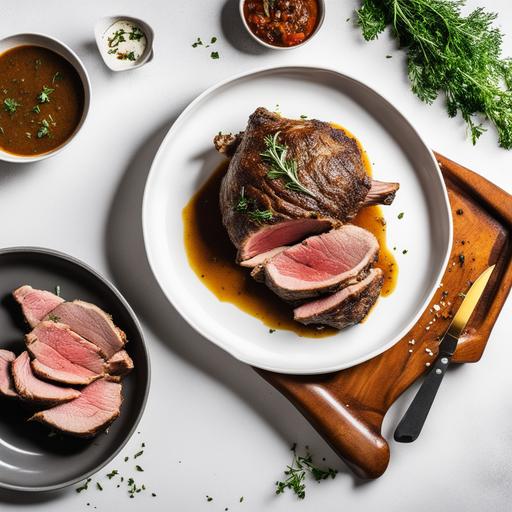
Once you’ve brought your leg of lamb home, it’s time to prepare it for the oven. Follow these steps for cleaning and preparation:
-
Rinsing: Rinse the leg of lamb under cold water to remove any excess blood or debris. Pat it dry using paper towels.
-
Trimming: Trim any excess fat, leaving a thin layer for flavor and moisture. Be cautious not to remove too much fat, as it adds richness and prevents the meat from drying out.
-
Marinades: You may choose to marinate your leg of lamb to infuse it with additional flavors. A traditional marinade includes olive oil, garlic, fresh herbs like rosemary and thyme, as well as salt and pepper. Let the lamb marinate for at least 2 hours to overnight, refrigerated and covered, to enhance tenderness and taste.
Tips for Cooking Leg of Lamb to Perfection
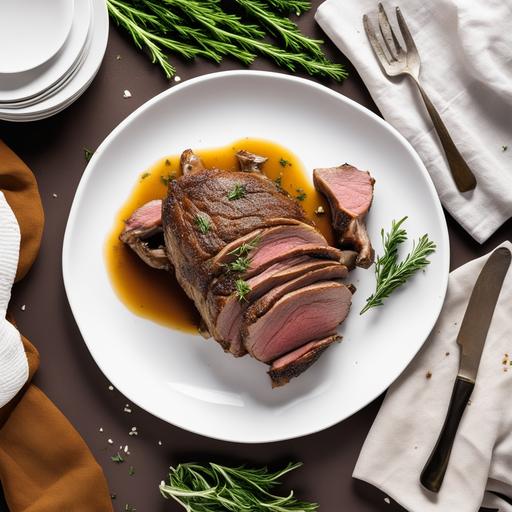
Cooking a leg of lamb may seem daunting, but with these expert tips, you’ll be on your way to culinary success:
-
Preheating the Oven: Always preheat your oven to the desired temperature before cooking the leg of lamb. This ensures even cooking and locks in flavors.
-
Using a Roasting Rack: Placing the leg of lamb on a roasting rack allows hot air to circulate around the meat, promoting even browning and preventing it from sitting in its juices.
-
Resting the Lamb: After removing the leg of lamb from the oven, let it rest for at least 15 minutes before carving. This allows the juices to redistribute, resulting in a more tender and flavorful final product.
-
Internal Temperature: Invest in a meat thermometer to accurately monitor the internal temperature of the lamb. Aim for the following doneness levels: 130°F for medium-rare, 145°F for medium, and 160°F for well-done.
Variations and Flavor Enhancements
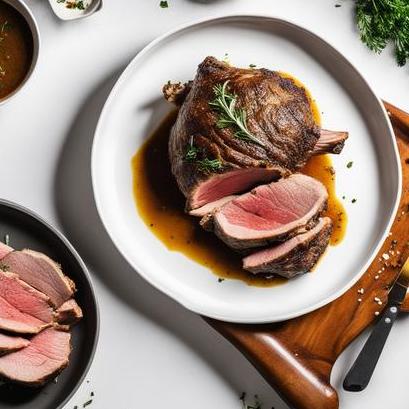
While a classic leg of lamb can be exceptional on its own, there are numerous variations and flavor enhancements to consider:
-
Herb Crust: Create a flavorful crust by coating the leg of lamb with a mixture of breadcrumbs, garlic, herbs, and olive oil. This adds an extra layer of texture and taste.
-
Citrus Infusion: Add brightness to your leg of lamb by incorporating citrus zest or juice into your seasoning or marinade. The acidity will help tenderize the meat and elevate the flavors.
-
Spice Rubs: Experiment with different spice rubs such as cumin, paprika, and coriander to create a unique and aromatic flavor profile.
Doneness Checks and Overcooking/Undercooking Risks
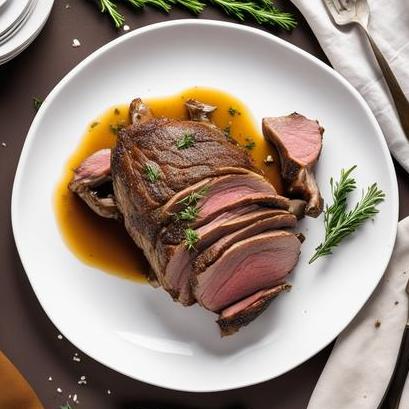
It’s essential to know how to check for doneness and be mindful of the risks of overcooking and undercooking when preparing a leg of lamb:
-
Doneness Checks: To check for doneness without relying solely on the thermometer, use the finger test. Press the meat with your finger; if it feels soft and springs back, it is cooked to medium. If it feels slightly firmer, it is medium-well, and if it feels firm, it has reached well-done.
-
Overcooking Risks: Overcooking a leg of lamb can result in dry and tough meat. Pay close attention to cooking times and internal temperatures to avoid this outcome.
-
Undercooking Risks: While lamb can be enjoyed slightly pink, undercooking poses health risks. Ensure that the internal temperature reaches a safe level to eliminate any potential harmful bacteria.
Mouthwatering Leg of Lamb Oven Recipe
Now, let’s explore a delicious leg of lamb oven recipe that will take your culinary skills to new heights:
Ingredients:
-
1 leg of lamb (bone-in or boneless, approximately 5-8 pounds)
-
4 garlic cloves, minced
-
2 tablespoons fresh rosemary, chopped
-
2 tablespoons fresh thyme, chopped
-
2 tablespoons olive oil
-
Salt and pepper to taste
Instructions:
-
Preheat your oven to 325°F (163°C).
-
In a small bowl, combine minced garlic, chopped rosemary, thyme, olive oil, salt, and pepper.
-
Place the leg of lamb on a roasting rack in a baking dish or roasting pan.
-
Rub the garlic and herb mixture all over the leg of lamb, ensuring it is evenly coated.
-
Insert a meat thermometer into the thickest part of the lamb, making sure it doesn’t touch bone.
-
Place the lamb in the preheated oven and roast until the desired internal temperature is reached.
-
Remove the leg of lamb from the oven and let it rest for at least 15 minutes before carving.
-
Slice the lamb against the grain and serve with your favorite side dishes. Enjoy the juicy and flavorful masterpiece you’ve created!
Conclusion
Cooking a leg of lamb in the oven can be a truly rewarding experience. By understanding the food science, selecting the perfect cut, following proper cleaning and preparation techniques, and employing tips and flavor variations, you can achieve culinary mastery. Remember to conduct doneness checks, avoid overcooking or undercooking risks, and use our mouthwatering leg of lamb oven recipe as a starting point. With practice, patience, and passion, you’ll be able to create a leg of lamb that will impress even the most discerning palates. Happy cooking!
Sources
FAQS On Leg Of Lamb Oven Recipe
What Is A Good Temperature To Cook A Leg Of Lamb In The Oven?
It is recommended to preheat your oven to 325°F (165°C) for cooking a leg of lamb. This temperature allows for even cooking and ensures that the meat reaches a safe internal temperature without overcooking the outside.
How Long Should I Cook A Leg Of Lamb In The Oven?
The cooking time for a leg of lamb in the oven will depend on the size and thickness of the meat. As a general guideline, plan to cook the lamb for 15-20 minutes per pound. Use a meat thermometer to ensure it reaches an internal temperature of 145°F (63°C) for medium-rare or 160°F (71°C) for medium.
Do I Need To Marinate The Leg Of Lamb Before Cooking It In The Oven?
Marinating the leg of lamb before cooking is not required, but it can enhance the flavor and tenderness of the meat. You can use a simple marinade of olive oil, garlic, herbs, and lemon juice, or choose a pre-made marinade from your local grocery store. Allow the lamb to marinate in the refrigerator for at least 2 hours, or overnight for a more pronounced flavor.
Should I Cover The Leg Of Lamb With Foil While Cooking It In The Oven?
It is typically recommended to cover the leg of lamb with foil for the first half of the cooking time to help retain moisture and prevent the exterior from becoming too dark. After the initial cooking period, remove the foil to allow the meat to develop a delicious crust and finish cooking to your desired level of doneness.
How Should I Carve And Serve A Leg Of Lamb After Cooking It In The Oven?
Allow the leg of lamb to rest for 15-20 minutes before carving to allow the juices to redistribute and ensure a tender, flavorful result. To carve, slice the meat against the grain into thin slices and serve with your favorite side dishes, such as roasted vegetables, couscous, or a fresh salad. Enjoy!


